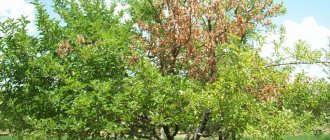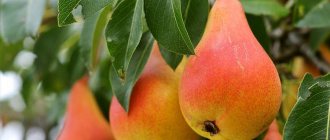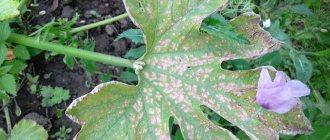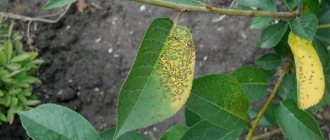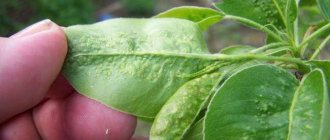Most experienced gardeners know that the main headache when growing carrots is the germination of the sown seeds. Many are sure that if the carrot has sprouted, then there will be no further problems with it.
However, there are almost a dozen carrot diseases. They all manifest themselves differently, are treated with different means and with varying degrees of success. In addition, we cannot exclude the influence of pests, which also cause significant damage to plantings.
In this article we will talk about the main diseases and insect pests of carrots, how they manifest themselves and how they can be controlled.
What causes carrots
The root vegetable, which does not require special care, is very sensitive to fungal and bacterial diseases. They cause crop loss during storage. Infections are transmitted through soil, water and contaminated seeds.
White rot
The initial stage of sclerotinia, or white rot, most often occurs without visible signs, and the gardener stores the vegetable, not suspecting that he is introducing a dangerous fungal infection into the bins. Moist, soft areas form on the carrot (the color does not change), which are gradually captured by the mycelium, growing on them in the form of a white fluffy coating. Later, the emerging drops of moisture harden and turn into black growths.
Excess nitrogen fertilizer increases the risk of developing white rot on carrots
You cannot cut off rotten roots and eat diseased root crops; you can only throw them away.
Many garden plants suffer from sclerotinia. It is better to plant carrots away from beans, cabbage, cucumbers, tomatoes and pumpkins.
Gray rot
Damaged, withered or frozen root crops stored for storage become prey to gray rot, or botrythiosis. The risk of damage increases many times over if carrots are stored next to cabbage. First, wet soft areas of a brownish color appear on the root crop; later it is enveloped in a gray coating, from which small hard fungal formations grow in the form of tubercles - sclerotia.
Gray rot can ruin up to 85% of the crop
Black rot
If the summer is hot with frequent rains and winds, the risk of carrots becoming infected with black rot - Alternaria - increases. Most often, obvious signs of fruit spoilage appear during storage. Dry spots of coal-black color form on root vegetables. The fungus “eats” the root crop to a depth of 1 cm.
The cause of the development of black rot can be excessive evening watering of carrots.
During storage, carrots soften, especially at high humidity.
Cercospora
Signs of cercospora blight usually appear on carrot tops by mid-summer. It spreads most often in cool, rainy weather. First, small light brown round spots with a whitish center form on the leaves. Later they completely lighten and grow, the tips of the leaves dry out and curl. The spots below are covered with a gray coating - these are fungal spores. Gradually, mold covers the entire surface of the leaf, it turns black and begins to rot. Due to damage to the leaf part of the plant, the root crops stop growing, resulting in carrots that are small and wrinkled.
The spots gradually become ulcers, which leads to the appearance of constrictions and the death of the above carrot leaf or stem
Brown spot
Cladosporiosis, or brown spot, looks like dark brown constrictions on young shoots. A plant that becomes diseased at an early age dies. In grown carrots, light yellow spots appear on the leaves, then they turn brown, surrounded by a yellow rim. In humid weather, the spots become covered with a dense black coating. Cladosporiosis, left unattended, can destroy the crop.
Spores of the pathogenic fungus that causes cladosporiosis are carried by wind, insects, and water
Powdery mildew
The leaves of carrots infected with powdery mildew become covered with a whitish coating, which reduces the photosynthesis of the plant. This impairs the development of the root crop. The fungus develops especially actively in hot, dry weather, when the plant experiences a lack of moisture and the leaves become lethargic.
A decrease in photosynthesis affects the nutrient content of the root crop and reduces its weight
Powdery mildew covers all above-ground parts of carrots - stems, petioles, leaves, seeds. The plaque, at first white and light, gradually thickens and becomes gray, in places covered with small dark spots. The affected parts become hard, turn brown and die. The roots of diseased plants stop growing and, as a result, turn out small and woody.
Prevention of carrot diseases
The best way to fight disease is prevention. You can do the following:
- for winter storage, choose late varieties that are less susceptible to infections;
- before sowing seeds, treat them in hot water (45–50 °C), then in cold water and finally soak for 10–15 minutes in a solution of potassium permanganate;
- Before planting, treat the soil with Immunocytophyte. When the young shoots grow a little, the treatment can be repeated;
- be sure to thin out carrots and remove all deformed, weak and infected plants;
- Spray carrot plantings with 1% Bordeaux mixture 2–3 times per season;
- do not delay harvesting until cold weather, collect carrots in warm, dry weather;
- During harvesting, sort root crops. Damaged, unripe or cracked ones should be set aside separately, as they are primarily susceptible to infection;
- before storing the crop, treat the storage area with bleach (400 g per 10 liters of water) at the rate of 2–3 kg of dry lime for every 10 m3 of room, then ventilate well;
- whitewash the shelves on which carrots will be stored;
- observe the temperature regime - the storage should be +1–2 °C.
Compliance with agricultural technology and crop rotation rules will save your harvest until the end of winter.
Move the carrots to different beds each year. It can be planted in one place no more than once every 4–5 years. The best predecessors are onions, potatoes, lettuce.
After harvesting, the spores and mycelium of the fungi remain in the ground and infect new plantings the following year, so do not neglect autumn harvesting. Plant debris infected with rot must be collected and burned, and the soil must be processed. Drugs of choice:
- copper sulfate (30 g per 10 liters of water);
- 1% solution of Bordeaux mixture;
- Hom (20 g per 10 liters of water).
They should be used at the rate of 1 liter of solution per 10 square meters. m of soil.
Video: harvesting and storing carrots
Treatment of diseases
If, despite all efforts to prevent carrot diseases, you find signs of infection in your plantings, emergency medical care will help save the crop:
- for gray rot of carrots, fertilizing with nitrogen fertilizers and spraying with preparations containing copper is necessary; the drug Rovral also helps well;
- white rot does not like potassium fertilizers - feed the carrots with potassium sulfate (1.5 tablespoons per 10 liters of water), it is also worth spraying the beds with Gliocardin;
- the drug Rovral helps well against black rot;
- with brown spotting, loosening the beds will help; for treatment, use the preparations Bravo, Quadris, Hom;
- fungicides Fitosporin-M, Topsin-M and copper sulfate (0.5%) save from powdery mildew;
- cercospora infection is effectively treated with biological products Quadris and Gamair;
- To prevent bacteriosis, carrots for winter storage should be sprayed with TMTD fungicide or dusted with chalk dust.
exclamation scoop
Another name for the pest is the fall armyworm. Butterfly caterpillars are especially dangerous. They are distinguished by a black stripe on the back. The pest feeds on the stems, their pre-root part, and also destroys the pulp of the root crop. Leaves passages and tunnels behind. Carrot yields are reduced as a result of the appearance of the caterpillar.
Pest control is carried out by:
- Using various insecticidal preparations. Spraying is carried out with microbiological preparations such as Decis, Polytrin, Fury.
- Folk methods of control come down to spraying plants with infusion of chamomile and burdock. The close proximity of these plants is good at repelling the butterfly. Gardeners advise releasing insects - Trichogramma. They handle the caterpillar effectively.
Preventive measures include autumn plowing of the soil, thorough destruction of weeds both during the growing season and during tillage in the fall.
Pest control often comes down to preventive measures. Constant care of the crop, loosening, treating the soil with fertilizers and following the rules of crop rotation contribute to a good carrot harvest.
Don't overdo it with nitrogen fertilizers. This can provoke the appearance of diseases and pests of carrots. Use phosphorus-potassium fertilizers, they will increase the yield of everyone’s favorite juicy carrots.
More information can be found in the video.
Pests
Another attack from which carrots have to be protected is pests. By feeding on its juices, they cause no less harm to the root crop than diseases.
carrot fly
The carrot fly is the most common and harmful pest of sweet vegetables. She lays eggs on the carrot itself and in the ground around it. The first carrot fly attack usually occurs at the end of May. At one time, the insect lays up to 120 eggs. The larvae that hatch from them gnaw through the root crop. Infection is determined by the color of the tops - they become bronze or purple - and by the taste of the root crop - it becomes bitter.
Photo gallery: carrot fly damage
Carrot fly larvae cause the main damage to carrots.
The tops first acquire an unnatural purple hue, then begin to turn yellow and gradually dry out
The carrots begin to rot because bacteria penetrate through the passages made by the larvae.
carrot psyllid
The carrot psyllid is a tiny (only 2 mm) light green insect. It attacks carrot plantings located next to coniferous trees. Larvae and adults feed on the juice of carrot leaves. The presence of psyllid can be determined by its twisted, curly leaves (like some varieties of parsley). By infecting them, the leaf flea flea causes irreparable damage to the root crop: it hardens and dries out.
Insecticides are used if psyllid infestation exceeds 15% of the total number of carrot plantings
Carrot moth
The carrot, or umbrella, moth has several varieties, the most harmful of which is considered to be the brown one, a small (1.5 cm) moth. The root crop itself and the seeds suffer from it. She weaves cocoons on the tops, from which voracious caterpillars emerge. Gradually, the plant begins to darken, dry out and subsequently die.
Insect caterpillars produce cobwebs, which they use to entangle carrot umbrellas and inflorescences and damage their structure.
Naked slugs
Naked slugs actively reproduce and damage carrots if they are planted in a low-lying place where moisture stagnates. An excellent living environment for them is a garden bed overgrown with weeds and littered with tops. At one time, the female lays up to 500 eggs. The slugs that emerge from them after 15–20 days become adults within a few days and destroy carrot plantings.
Constantly clearing the soil of weeds is one of the best methods of combating naked slugs.
They eat young shoots, mature plants and even seeds. Slugs eat deep holes in root crops. They are most active at night, and during the day their presence will be indicated by a white shiny mark on a stem or leaf.
Carrot moth
An adult butterfly reaches 18 mm in size. The front wings are dark brown in color, the hind wings are grayish-pink. The chest and head are colored light yellow. Butterflies fly out in the second half of June. They lay greenish eggs on the inflorescences of the plant. The caterpillars emerging from the eggs grow up to 13 mm long, have a black head and a brown body with a pinkish tint, along which there are white tubercles. Moth caterpillars secrete cobwebs that entangle the inflorescences and umbels of the plant, thereby damaging them. The caterpillars pupate in August, and after some time the second generation moth appears.
They fight carrot moths with chemical and biological preparations (lepidocide, dendrobacillin, entobacterin, etc.), herbal remedies, treating inflorescences with them during budding. It is useful to mow umbrella weeds, destroying plant debris. Prevention measures also include early harvesting of carrots followed by threshing of the seeds.
Prevention measures
Most pests lay eggs in the soil, where they overwinter, and in the spring they hatch into larvae. Therefore, the main preventive measures are:
- deep autumn digging of the soil and treating it with insecticides;
- maximum weed control throughout the summer season.
Deep autumn digging of the bed reduces the number of pests overwintering in the soil
Many insects are afraid of specific odors; they are repelled by the pungent aromas of spicy plants. Therefore, you can plant onions or cilantro between the rows. Green tomato tops also have an unpleasant odor for insects. It is buried in the beds between the rows.
Causes of parasites
Pests can appear in the area where carrots are planted in several ways. Some types of pests appear as a result of incorrect agricultural practices, also associated with violation of crop rotation rules. Some types of insects simply fly from one vegetable crop to another if they are not constantly controlled. Prevention measures play an important role.
How to remove pests
The chemical industry offers many products to kill insects. Folk remedies are no less effective against them. If you find harmful insects on carrots, take the following measures:
- Almost all pests are afraid of wood ash. Mix it with tobacco dust in equal parts and sprinkle the mixture on the soil between the rows. Carry out the treatment three times every 10 days;
- Place the bed away from coniferous plantings to protect the carrots from psyllids. Spray infected plantings with tobacco infusion (400 g of tobacco dust per 10 liters of water, leave for 2 days, then dilute with the same amount of water and add 40 g of soap). Tobacco infusion will also get rid of carrot aphids. Against psyllids, use the insecticides Arivo, Actellik, Tsimbush, Decis. Processing should be stopped a month before eating carrots;
Insecticide Decis affects insects through the integument and during feeding
- If you find slugs, clear the carrot bed of weeds and rotted tops as quickly as possible. Treat the soil with a 30% lime solution with the addition of ash or superphosphate, and the plants with a 10% salt solution. It is better to do this at night, during the period of slug activity;
- mechanically clean the plantings to remove carrot moth and cutworm caterpillars. To do this, cut off the above-ground part of the carrot along with the caterpillars and destroy. Spray the plants with Lepidocide or the biological insecticide Entobacterin;
- against wireworms, dig the soil deeply in the fall and apply ammonia fertilizers (for example, ammonium nitrate at the rate of 25 g per 1 sq. m). There should be no wheatgrass near the carrots - a weed especially loved by wireworms. Treat the soil with Bazudin or Etonem-F;
- against mole crickets, pour kerosene on the sand (60–70 ml per 1 kg), mix it with dry soil, and sprinkle it between the rows in the garden bed (the insect cannot tolerate the smell of petroleum products). You can also water the garden bed with an infusion of pepper or mustard.
